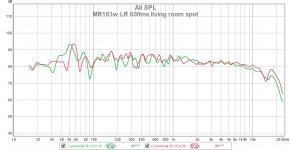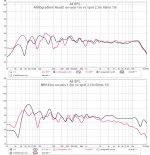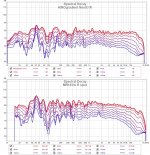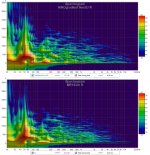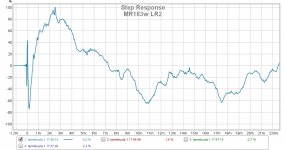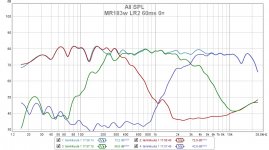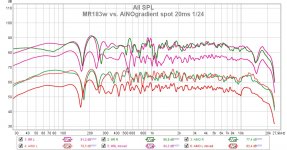Some more measurements added in shared Google folder. Hypex HFD program is nasty, one must upload filters and remember to save the project file several times during setting session. Guess who often forgets to save it... Measuring a large 3-way speaker indoors is troublesome. Coaxial MT is easy, but the woofer on the bottom is not - it uses bondary reflections as essential part of response eq, and measuring it on the table shows always strange wobbles.
MR183w active by Juhazi - specifications:
W SB Acoustics 29NRX75-6, sealed 40L, downfire
M SEAS MR18REX in 7L aperiodic ball, loose polyfill.
T SEAS T18ACG (replacement) with serial 8.5mH Jantzen Cross-Cap
Hypex FA123 dsp and Ncore 2x125W, 1x100W
-crossovers acoustic LR2 at 300/3000Hz, eq 3 biquads per section, 544us delay for MT section, gain adjust
MT enclosure form 2 IKEA Blanda bowls
W enclosure from Biltema cardboard casting tube, plywood bottom and top plates
-furniture cloth sleeve, 3 furniture legs/speaker
Total BOM for a pair appr. 1600€ (I used second hand drivers)
Room response at spot without room-eq
MR183w active by Juhazi - specifications:
W SB Acoustics 29NRX75-6, sealed 40L, downfire
M SEAS MR18REX in 7L aperiodic ball, loose polyfill.
T SEAS T18ACG (replacement) with serial 8.5mH Jantzen Cross-Cap
Hypex FA123 dsp and Ncore 2x125W, 1x100W
-crossovers acoustic LR2 at 300/3000Hz, eq 3 biquads per section, 544us delay for MT section, gain adjust
MT enclosure form 2 IKEA Blanda bowls
W enclosure from Biltema cardboard casting tube, plywood bottom and top plates
-furniture cloth sleeve, 3 furniture legs/speaker
Total BOM for a pair appr. 1600€ (I used second hand drivers)
Room response at spot without room-eq
Attachments
Last edited:
Listening impressions and some comparative measurements
So, I have for more than a week listened to MR183w sitting next to my AINOgradients in my living room. Impressions verify my initial thoughts, but it was about five years from previous side-by-side comparison of dipole vs. monopole! I have adjusted settings in dsp by listening and measuring, several iterations. I have bad hearing of high frequencies, and sound changes every time I swallow or yawn. This and challenges of taking measurements indoors are making this stage a bit frustrating and time consuming. Naturally my dog and other family members have been asked for opinion.
Frequency balance - a matter of eq settings, but the different directivity proflile of speakers makes MR183w more difficult to set - measurements and audition don't go so much hand in hand as with AINOs. Treble balance changes more off-axis with MR183w.
Frequency extension - par because both have closed box downfire 10" bass. Room response within 6dB 15-15 000Hz for both.
Definition, imaging, clarity - MR183w wins here. Bass notes and harmonics sound very good and punchy. AINOs are cardiod around 100-300Hz and obviously changing directivity affects room response making it less uniform. This can be seen in spectrogram too. In midrange MR183w sounds accurate and more "like loudspeakers", AINOs sound more diffuse/lifelike specially with classical music and speech. With eyes closed it is easy to hear that dipoles sound more 3-dimensional.
Conclusion - MR183w sounds like very good typical monopole co-axial speakers, with precise imaging and are good for people who listen mostly pop/rock etc. music recorded in studios. For classical and vocal music dipoles sound more natural and sound tonality doesn't change hardly at all off-axis or when walking around in the room.
In attached measurements neither speaker is exactly as they were set for listening, so they are not directly 100% comparable.
So, I have for more than a week listened to MR183w sitting next to my AINOgradients in my living room. Impressions verify my initial thoughts, but it was about five years from previous side-by-side comparison of dipole vs. monopole! I have adjusted settings in dsp by listening and measuring, several iterations. I have bad hearing of high frequencies, and sound changes every time I swallow or yawn. This and challenges of taking measurements indoors are making this stage a bit frustrating and time consuming. Naturally my dog and other family members have been asked for opinion.
Frequency balance - a matter of eq settings, but the different directivity proflile of speakers makes MR183w more difficult to set - measurements and audition don't go so much hand in hand as with AINOs. Treble balance changes more off-axis with MR183w.
Frequency extension - par because both have closed box downfire 10" bass. Room response within 6dB 15-15 000Hz for both.
Definition, imaging, clarity - MR183w wins here. Bass notes and harmonics sound very good and punchy. AINOs are cardiod around 100-300Hz and obviously changing directivity affects room response making it less uniform. This can be seen in spectrogram too. In midrange MR183w sounds accurate and more "like loudspeakers", AINOs sound more diffuse/lifelike specially with classical music and speech. With eyes closed it is easy to hear that dipoles sound more 3-dimensional.
Conclusion - MR183w sounds like very good typical monopole co-axial speakers, with precise imaging and are good for people who listen mostly pop/rock etc. music recorded in studios. For classical and vocal music dipoles sound more natural and sound tonality doesn't change hardly at all off-axis or when walking around in the room.
In attached measurements neither speaker is exactly as they were set for listening, so they are not directly 100% comparable.
Attachments
Last edited:
I wasn't totally happy with the duelundish crossover topologies, so went to textbook LR2. Clarity of treble improved and now I think that these are ready to be delivered to my daughter!
These responses were taken at 1,7m in-room so they contain reflections around WM xo. Eq and delay were set based on several better measurements for each purpose.
These responses were taken at 1,7m in-room so they contain reflections around WM xo. Eq and delay were set based on several better measurements for each purpose.
Attachments
Hi Juhazi,
Just curious - any specific reason for such high crossover to the down-firing woofer? Have you compared it to lower crossover point? Is this really not affecting sound?
Just curious as my own design (as you know) has side firing woofers. Theory says it should be bad to go above 80Hz (directional sound) with drivers not facing the listener. However, I am a rookie so I have no experience to base it on. Never heard a speaker with 1+7+10+10 like mine with all drivers facing forward so i can't really compare.
Just curious - any specific reason for such high crossover to the down-firing woofer? Have you compared it to lower crossover point? Is this really not affecting sound?
Just curious as my own design (as you know) has side firing woofers. Theory says it should be bad to go above 80Hz (directional sound) with drivers not facing the listener. However, I am a rookie so I have no experience to base it on. Never heard a speaker with 1+7+10+10 like mine with all drivers facing forward so i can't really compare.
My midrange is true midrange, it has low xmax which doesn't allow low xo. And using shallow LR2 slopes that is emphasized.
Other reason is that this way I almost totally get rid of typical floor bounce around 300-400Hz of midrange.
Overall it sounds very good! Low notes of double bass, drums, electric bass etc. contain lots of harmonics in range of several hundreds of Hz and they sound very natural now.
With your FA123 it is very easy to test this too! With LR2 slopes and perfected step response, bass is only half cycle behind mid at xo, so it has only half of the group delay of LR4 bass. I have experiencedLR4 makes bass loose it's punchiness, just like bass reflex tuning does. I want to get rid of those! I have set my home theater sub (2x15" closed) also to LR2 around 100Hz with minidsp and it is sounds very good too. With movie rumbles there is no difference, but with music yes! I will neve go back with this, but it is personal of course. Please try it!
Check other large 3-way speaker desings, in most caes WM xo is LR2 around 300Hz. Wilson Alexia has LR2 at 200Hz but timing isn't spot on. Wilson Audio Specialties Alexia Series 2 loudspeaker Measurements | Stereophile.com
Other reason is that this way I almost totally get rid of typical floor bounce around 300-400Hz of midrange.
Overall it sounds very good! Low notes of double bass, drums, electric bass etc. contain lots of harmonics in range of several hundreds of Hz and they sound very natural now.
With your FA123 it is very easy to test this too! With LR2 slopes and perfected step response, bass is only half cycle behind mid at xo, so it has only half of the group delay of LR4 bass. I have experiencedLR4 makes bass loose it's punchiness, just like bass reflex tuning does. I want to get rid of those! I have set my home theater sub (2x15" closed) also to LR2 around 100Hz with minidsp and it is sounds very good too. With movie rumbles there is no difference, but with music yes! I will neve go back with this, but it is personal of course. Please try it!
Check other large 3-way speaker desings, in most caes WM xo is LR2 around 300Hz. Wilson Alexia has LR2 at 200Hz but timing isn't spot on. Wilson Audio Specialties Alexia Series 2 loudspeaker Measurements | Stereophile.com
About directionality, You have stereo speakers! HT sub 80Hz recommendation is for typical situation of having just one sub that gets summed L+R signal.
I just love Stereophile tests! Magico S5MkII has two woofers near floor, xo is LR4 at 300Hz. It measures even better in-room than Wilson Alexia! Magico has room dip at 300Hz, that might get smoother with LR2...
Magico S5 Mk.II loudspeaker Measurements | Stereophile.com
I just love Stereophile tests! Magico S5MkII has two woofers near floor, xo is LR4 at 300Hz. It measures even better in-room than Wilson Alexia! Magico has room dip at 300Hz, that might get smoother with LR2...
Magico S5 Mk.II loudspeaker Measurements | Stereophile.com
Last edited:
Aaah okay it makes sense if your midrange cannot handle the displacement!
I see many three-way (also Troels Gravesens build have XO in the 300-500Hz range to bass driver, but I dind't think it would work in my configuration).
I also feel my bass isn't as punchy as I would like it to be. I use LR4 filters and cross at 150 Hz.
I will definitely try LR2 filters and higher XO then!
Sorry, I din't mean to steal the spotlight from your build! I still really like your speaker as well!
I see many three-way (also Troels Gravesens build have XO in the 300-500Hz range to bass driver, but I dind't think it would work in my configuration).
I also feel my bass isn't as punchy as I would like it to be. I use LR4 filters and cross at 150 Hz.
I will definitely try LR2 filters and higher XO then!
Sorry, I din't mean to steal the spotlight from your build! I still really like your speaker as well!
I had a day off from work so some more tweaking and measurements. Woofer-mid timing has been very tricky, but now I think they are on same cycle, mid has 436us delay and tweeter only 322 to woofer. The alu tweeter sits deeper than the original.
I tried to match response to AINOgradient, but still in these measurements the mid blows too hard between 200-400Hz and tweeter 3-5kHz. I adjusted those afterwards, now their sound signature comes from different radiation patterns. Speakers were side by side and I also moved left speakers 10" closer to see how response changes. MR183w measurements show a wiggle around 1kHz and it comes most likely from my laptop near the mic, because it disappears when I moved the speaker and moved the laptop too. Dipole speaker is less affected with positioning and has overall less wiggles in response despite being relatively close to front wall!
One major finding is again, that small wiggles in response are artefacts from reflections. 1/3 octave smoothing tells best how the speaker sounds.
More graphics here
I tried to match response to AINOgradient, but still in these measurements the mid blows too hard between 200-400Hz and tweeter 3-5kHz. I adjusted those afterwards, now their sound signature comes from different radiation patterns. Speakers were side by side and I also moved left speakers 10" closer to see how response changes. MR183w measurements show a wiggle around 1kHz and it comes most likely from my laptop near the mic, because it disappears when I moved the speaker and moved the laptop too. Dipole speaker is less affected with positioning and has overall less wiggles in response despite being relatively close to front wall!
One major finding is again, that small wiggles in response are artefacts from reflections. 1/3 octave smoothing tells best how the speaker sounds.
More graphics here
Attachments
Last edited:
Speakers were delivered to the end user, my daughter Alisa. She lives in an apartment that has solid walls, the listening room is open to bedroom so there is room for a 20Hz mode! Other direction modes around 50Hz are wild too. Still, RT30 is around .4 which is ok. I had to tame bass about 5-6dB and some more eq to get sound right. But no eq for modes!
Measurements at the end of gallery
Measurements at the end of gallery
Project
Hi Juhazi,
First of all I would like to congratulate for your work!
Second, I'm planning to build same type of speakers with a similar design as yours which I understood is based on Gradient.
I'm planning to build same type of speakers with a similar design as yours which I understood is based on Gradient.
Can you recommend some other drivers or should I go with your current set-up
29NRX75 & MR18REX?
Regards.
Hi Juhazi,
First of all I would like to congratulate for your work!
Second,
Can you recommend some other drivers or should I go with your current set-up
29NRX75 & MR18REX?
Regards.
Hi,
Original has reflex bass with 8" driver, but because I hate BR and go active with dsp, I chose a 10" sealed with low Fs and high Xmax. Similar drivers are Peerless XLS10, XXLS10, SEAS L26RO4Y and many others exist too.
For coaxial we have many options too, SEAS T18 and SEAS C18 are better than MR18 actually. I don't have experience of other makes, but the new Tangband is pretty! I might by TB now.
Actualy soundwise, I don't believe that drivers sound so different. One exception is midrange's cone resonance, don't choose an aluminium cone! I bought my drivers from national hifi forum members, second hand, long time before I started this project.
Please keep us informed and feel free to send private mail.
Original has reflex bass with 8" driver, but because I hate BR and go active with dsp, I chose a 10" sealed with low Fs and high Xmax. Similar drivers are Peerless XLS10, XXLS10, SEAS L26RO4Y and many others exist too.
For coaxial we have many options too, SEAS T18 and SEAS C18 are better than MR18 actually. I don't have experience of other makes, but the new Tangband is pretty! I might by TB now.
An externally hosted image should be here but it was not working when we last tested it.
Actualy soundwise, I don't believe that drivers sound so different. One exception is midrange's cone resonance, don't choose an aluminium cone! I bought my drivers from national hifi forum members, second hand, long time before I started this project.
Please keep us informed and feel free to send private mail.
Hi,
Thank you for the prompt replay.
I was thinking about L26RO4Y and XXLS also for the low end, for the mids & highs the Tang Band W6-2313 looks so cool.
I'm an electronic engineer but I don't much experience in audio measurements and crossover design so any help will be beneficial for me in choosing the right components for the start.
Regards
Thank you for the prompt replay.
I was thinking about L26RO4Y and XXLS also for the low end, for the mids & highs the Tang Band W6-2313 looks so cool.
I'm an electronic engineer but I don't much experience in audio measurements and crossover design so any help will be beneficial for me in choosing the right components for the start.
Regards
With passive crossovers I can't help, sorry! But the drivers mentioned should not be difficult in any way, but bass needs quite a lot of massaging. Bass impulse comes delayed to the listener, so mid and tweeter would benefit from 0,5ms delay. That might not be possible with passive circuit, but original is passive any way...
Last edited:
The hardest part was how to eq the bass response. Downfire has floor boost as given and the slot makes strange things like the proximity of wall. Simple simulations can't give even a clue of those, one must take several measurements with different positioning of mic and speaker to find a working compromise.
First you must learn to make measurements and then for passive xo, learn some design/simulation program using those. Vituixcad is best choice and you should learn it quite easily, being familiar with electronics and maths.
I am too dumb, lazy and old to learn using simulation software, so multichannel dsp is my only choice to do it myself.
First you must learn to make measurements and then for passive xo, learn some design/simulation program using those. Vituixcad is best choice and you should learn it quite easily, being familiar with electronics and maths.
I am too dumb, lazy and old to learn using simulation software, so multichannel dsp is my only choice to do it myself.
- Home
- Loudspeakers
- Multi-Way
- SEAS MR18 3-way
